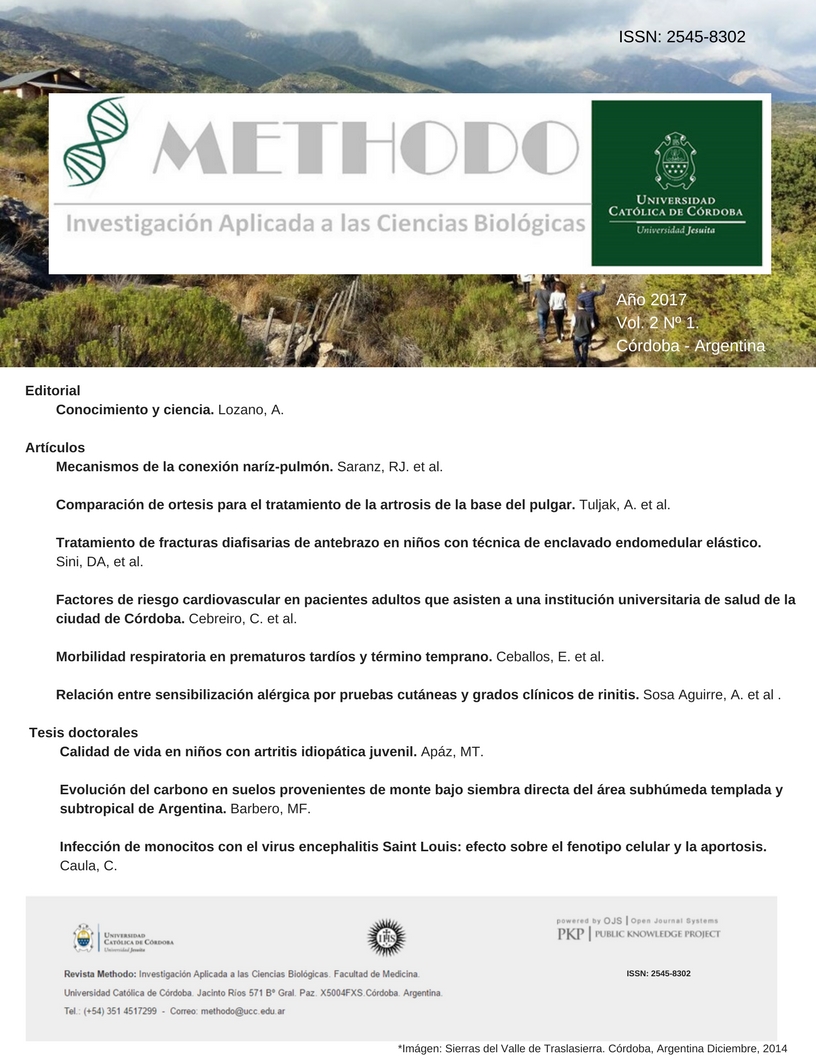Infección de monocitos con el virus encephalitis Saint Louis: efecto sobre el fenotipo celular y la aportosis
Palabras clave:
SLEV, monocitos, apoptosis, fenotipoResumen
Los flavivirus transmitidos por los mosquitos son una gran amenaza actual y emergente, que afecta a millones de personas en todo el mundo. La forma grave de enfermedad comprende la neuroinvasiva descripta para el virus encephalitis Saint Louis (SLEV), el virus de la Encefalitis Japonesa (JEV, Japanese Encephalitis virus) y el virus del Oeste del Nilo (WNV, West Nile virus), como también la forma hemorrágica desencadenada por el virus del dengue (DENV). En este contexto, la respuesta inmune es un componente crucial de la defensa del huésped, ya que su compromiso podría tener consecuencias sobre la virulencia de la cepa y la fisiopatogenia de la infección. En este trabajo se investigó la interacción entre SLEV y células de la inmunidad innata, en un modelo de infección in vitro de monocitos humanos (células U937) con cepas de distinta virulencia y condiciones epidemiológicas de aislamiento (Cba-Ar 4005 y 78V-6507). Se evaluó la capacidad de infectar y replicar del virus, se identificó y cuantificó la forma de muerte del monocito y se caracterizó el perfil fenotípico y funcional de esta célula mediante la determinación de marcadores de maduración y activación (CD14, HLA-DR), la expresión de TLR (Toll-like receptor) y mediadores biológicos secretados (TNF,IL-6,IL-10). Como resultado de este trabajo de Tesis se ha demostrado la susceptibilidad de células humanas de linaje monocítico a la infección y replicación por ambas cepas de SLEV. Se ha identificado que la infección por SLEV CbaAr-4005 induce la maduración y activación del monocito hacia un fenotipo inflamatorio M1 que no logra limitar la infección y promueve su muerte por un mecanismo apoptótico mediado por caspasa-3 inducida por vía intrínseca y posiblemente extrínseca. En cambio, la infección por SLEV 78V-6507, induce al monocito hacia un fenotipo regulador M2 que modula su activación y con ello limita su muerte junto con la replicación viral y la infección. Las diferencias halladas en la interacción entre las cepas de SLEV y el monocito, podrían justificar, en parte, el comportamiento epidemiológico y las diferencias de virulencia en modelo murino y aviario manifestado por estas cepas.Descargas
Referencias
Harris P, Ralph P. Human leukemic models of myelomonocytic development: a review of the HL-60 and U937 cell lines. J Leukoc Biol. 1985;37:407-22. https://doi.org/10.1002/jlb.37.4.407
Baek Y-S, Haas S, Hackstein H, Bein G, Hernandez-Santana M, Lehrach H, et al. Identification of novel transcriptional regulators involved in macrophage differentiation and activation in U937 cells. BMC Immunol. 2009;10:18. https://doi.org/10.1186/1471-2172-10-18
Sintiprungrat K, Singhto N, Sinchaikul S, Chen S-T, Thongboonkerd V. Alterations in cellular proteome and secretome upon differentiation from monocyte to macrophage by treatment with phorbol myristate acetate: insights into biological processes. J Proteomics. 2010;73(3):602-18. https://doi.org/10.1016/j.jprot.2009.08.001
Ashhurst TM, Vreden C Van, Munoz-erazo L, Niewold P, Watabe K, Terry RL, et al. Antiviral macrophage responses in flavivirus encephalitis. Indian J Med Res. 2013;138:632-47.
Geissmann F, Manz MG, Jung S, Sieweke MH, Ley K. Development of monocytes, macrophages and dendritic cells. Science. 2010;327(5966):656- 61. https://doi.org/10.1126/science.1178331
Klomporn P, Panyasrivanit M, Wikan N, Smith DR. Dengue infection of monocytic cells activates ER stress pathways, but apoptosis is induced through both extrinsic and intrinsic pathways. Virology. 2011;409(2):189-97. https://doi.org/10.1016/j.virol.2010.10.010
Puerta-Guardo H, Mosso C, Medina F, Liprandi F, Ludert JE, del Angel RM. Antibody-dependent enhancement of dengue virus infection in U937 cells requires cholesterol-rich membrane microdomains. J Gen Virol. 2010;91(2):394-403. https://doi.org/10.1099/vir.0.015420-0
Chan JF-W, Yip CC-Y, Tsang JO-L, Tee K-M, Cai J-P, Chik KK-H, et al. Differential cell line susceptibility to the emerging Zika virus: implications for disease pathogenesis, non-vector-borne human transmission and animal reservoirs. Emerg Microbes Infect 2016;5(8):1-12. https://doi.org/10.1038/emi.2016.99
Barros VED, Ferreira BR, Livonesi M, Figueiredo LTM. Cytokine and nitric oxide production by mouse macrophages infected with Brazilian flaviviruses. 112 Rev Inst Med trop S Paulo. 2009;51(3):141-7. https://doi.org/10.1590/S0036-46652009000300004
Parquet MC, Kumatori A, Hasebe F, Mathenge EGM, Morita K. St. Louis encephalitis virus induced pathology in cultured cells. Arch Virol. 2002;147(6):1105-19. https://doi.org/10.1007/s00705-002-0806-6
Torrentes-Carvalho A, Azeredo EL, Reis SRI, Miranda AS, Gandini M, Barbosa LS, et al. Dengue-2 infection and the induction of apoptosis in human primary monocytes. Mem Inst Oswaldo Cruz. 2009;104(8):1091-9. https://doi.org/10.1590/S0074-02762009000800005
Aleyas AG, George J a, Han YW, Rahman MM, Kim SJ, Han SB, et al. Functional modulation of dendritic cells and macrophages by Japanese encephalitis virus through MyD88 adaptor molecule-dependent and - independent pathways. J Immunol. 2009;183(4):2462-74. https://doi.org/10.4049/jimmunol.0801952
Rivarola ME. Procesos Patogénicos e Inmunológicos en la Infección con Virus Encefalitis San Luis (VESL) en modelo murino. Tesis doctoral. Facultad de Ciencias Exactas, Físicas y Naturales. Universidad Nacional de Córdoba; 2015.
Samuel MA, Diamond MS. Pathogenesis of West Nile Virus infection: a balance between virulence, innate and adaptive immunity, and viral evasion. J Virol. 2006;80(19):9349-60. https://doi.org/10.1128/JVI.01122-06
Bai F, Kong K-F, Dai J, Qian F, Zhang L, Brown CR, et al. A paradoxical role for neutrophils in the pathogenesis of West Nile virus. J Infect Dis. 2010 Dec 15;202(12):1804-12. https://doi.org/10.1086/657416
Vogel P, Kell WM, Fritz DL, Parker MD, Schoepp RJ. Early events in the pathogenesis of eastern equine encephalitis virus in mice. Am J Pathol 2005;166(1):159-71. https://doi.org/10.1016/S0002-9440(10)62241-9
Wang Y, Lobigs M, Lee E, Müllbacher A. CD8+ T cells mediate recovery and immunopathology in West Nile virus encephalitis. J Virol. 2003;77(24):13323- 34. https://doi.org/10.1128/JVI.77.24.13323-13334.2003
Ye J, Zhu B, Fu ZF, Chen H, Cao S. Immune evasion strategies of flaviviruses. Vaccine. 2013;31(3):461-71. https://doi.org/10.1016/j.vaccine.2012.11.015
Diamond MS, Edgil D, Roberts TG, Lu B, Harris E. Infection of human cells by 113 dengue virus is modulated by different cell types and viral strains. J Virol. 2000;74(17):7814-23. https://doi.org/10.1128/JVI.74.17.7814-7823.2000
Lindenbach BD, Rice CM. Flaviviridae: The Viruses and Their Replication. In: Knipe DM, Howley PM, editors. Fields Virology. 2007th ed. Philadelphia: Lippincott-Raven Publishers; 2007. p. 1101-51.
Lim SM, Koraka P, van Boheemen S, Roose JM, Jaarsma D, van de Vijver DAMC, et al. Characterization of the Mouse Neuroinvasiveness of Selected European Strains of West Nile Virus. PLoS One. 2013;8(9):1-14. https://doi.org/10.1371/journal.pone.0074575
Nathanson N, Cole GA. Fatal Japanese encephalitis virus infection in immunosuppresed spider monkeys. Clin Exp Immunol. 1970;6(1):161-6.
Rivarola ME, Tauro LB, Llinás GA, Contigiani MS. Virulence variation among epidemic and non-epidemic strains of Saint Louis encephalitis virus circulating in Argentina. Memórias do Inst Oswaldo Cruz. 2014 Apr;109(2):197-201. https://doi.org/10.1590/0074-0276130475
Diaz LA, Nemeth NM, Bowen RA, Almiron WR, Contigiani MS. Comparison of Argentinean Saint Louis encephalitis virus non-epidemic and epidemic strain infections in an avian model. PLoS Negl Trop Dis. 2011;5(5):1-7. https://doi.org/10.1371/journal.pntd.0001177
Ahantarig A, Rüžek D, Vancová M, Janowitz A, Št'Astná H, Tesařová M, et al. Tick-borne encephalitis virus infection of cultured mouse macrophages. Intervirology. 2009;52(5):283-90. https://doi.org/10.1159/000235741
Donadieu E, Bahuon C, Lowenski S, Zientara S, Coulpier M, Lecollinet S. Differential virulence and pathogenesis of West Nile viruses. Viruses. 2013 Nov 22;5(11):2856-80. https://doi.org/10.3390/v5112856
Chaturvedi UC, Nagar R, Shrivastava R. Macrophage & dengue virus: Friend or foe? Indian J Med Res. 2006;124(1):23-40.
Mackenzie JM, Khromykh AA, Parton RG. Cholesterol Manipulation by West Nile Virus Perturbs the Cellular Immune Response. Cell Host Microbe. 2007;2(4):229-39. https://doi.org/10.1016/j.chom.2007.09.003
Chunhakan S, Butthep P, Yoksan S, Tangnararatchakit K, Chuansumrit A. Vascular leakage in dengue hemorrhagic fever is associated with dengue infected monocytes, monocyte activation/exhaustion, and cytokines production. 114 Int J Vasc Med. 2015;2015: 1-9. https://doi.org/10.1155/2015/917143
Brown MG, Huang YY, Marshall JS, King CA, Hoskin DW, Anderson R. Dramatic caspase-dependent apoptosis in antibody-enhanced dengue virus infection of human mast cells. J Leukoc Biol. 2009;85(1):71-80. https://doi.org/10.1189/jlb.0308167
Silveira GF, Meyer F, Delfraro A, Mosimann ALP, Coluchi N, Vasquez C, et al. Dengue virus type 3 isolated from a fatal case with visceral complications induces enhanced proinflammatory responses and apoptosis of human dendritic cells. J Virol. 2011;85(11):5374-83. https://doi.org/10.1128/JVI.01915-10
Ghosh Roy S, Sadigh B, Datan E, Lockshin R a, Zakeri Z. Regulation of cell survival and death during Flavivirus infections. World J Biol Chem. 2014;5(2):93-105. https://doi.org/10.4331/wjbc.v5.i2.93
Parquet M del C, Kumatori A, Hasebe F, Morita K, Igarashi A. West Nile virusinduced bax-dependent apoptosis. FEBS Lett. 2001;500(1-2):17-24. https://doi.org/10.1016/S0014-5793(01)02573-X
Samuel M a, Morrey JD, Diamond MS. Caspase 3-dependent cell death of neurons contributes to the pathogenesis of West Nile virus encephalitis. J Virol. 2007;81(6):2614-23. https://doi.org/10.1128/JVI.02311-06
Liao CL, Lin YL, Wang JJ, Huang YL, Yeh CT, Ma SH, et al. Effect of enforced expression of human bcl-2 on Japanese encephalitis virus-induced apoptosis in cultured cells. J Virol. 1997;71(8):5963-71. https://doi.org/10.1128/jvi.71.8.5963-5971.1997
Su H-L, Liao C-L, Lin Y-L. Japanese Encephalitis Virus Infection Initiates Endoplasmic Reticulum Stress and an Unfolded Protein Response. J Virol. 2002;76(9):4162-71. https://doi.org/10.1128/JVI.76.9.4162-4171.2002
Yanga T-C, Shiua S-L, Chuanga P-H, Linb Y-J, Wanb L, Lanc Y-C, et al. Japanese encephalitis virus NS2B-NS3 protease induces caspase 3 activation and mitochondria-mediated apoptosis in human medulloblastoma cells. Virus Res. 2008;143(1):77-85. https://doi.org/10.1016/j.virusres.2009.03.007
Myint KS, Endy TP, Mongkolsirichaikul D, Manomuth C, Kalayanarooj S, Vaughn DW, et al. Cellular immune activation in children with acute dengue virus infections is modulated by apoptosis. J Infect Dis. 2006;194(5):600-7. https://doi.org/10.1086/506451
Jaiyen Y, Masrinoul P, Kalayanarooj S, Pulmanausahakul R, Ubol S. 115 Characteristics of dengue virus-infected peripheral blood mononuclear cell death that correlates with the severity of illness. Microbiol Immunol. 2009;53(8):442-50. https://doi.org/10.1111/j.1348-0421.2009.00148.x
Diaz LA, Ré V, Almirón WR, Farías A, Vázquez A, Sanchez-Seco MP, et al. Genotype III Saint Louis encephalitis virus outbreak, Argentina, 2005. Emerg Infect Dis. 2006;12(11):1752-4. https://doi.org/10.3201/eid1211.060486
Mitchell C, Darsie RJ, Monath T, Sabattini M, Daffner J. The use of an animalbaited net trap for collecting mosquitoes during western equine encephalitis investigations in Argentina. J Am Mosq Control Assoc. 1985;1:43-7.
Wu H, Che X, Zheng Q, Wu A, Pan K, Shao A, et al. Caspases: A molecular switch node in the crosstalk between autophagy and apoptosis. Int J Biol Sci. 2014;10(9):1072-83. https://doi.org/10.7150/ijbs.9719
Wang X, Yang C, Chai J, Shi Y, Xue D. Mechanisms of AIF-Mediated Apoptotic DNA Degradation in Caenorhabditis elegans. Science. 2002;298(5598):1587- 92. https://doi.org/10.1126/science.1076194
Yang JS, Ramanathan MP, Muthumani K, Choo AY, Jin SH, Yu QC, et al. Induction of inflammation by West Nile Virus capsid through the caspase-9 apoptotic pathway. Emerg Infect Dis. 2002;8(12):1379-84. https://doi.org/10.3201/eid0812.020224
Yang MR, Lee SR, Oh W, Lee EW, Yeh JY, Nah JJ, et al. West Nile virus capsid protein induces p53-mediated apoptosis via the sequestration of HDM2 to the nucleolus. Cell Microbiol. 2008;10(1):165-76. https://doi.org/10.1111/j.1462-5822.2007.01027.x
Catteau A, Kalinina O, Wagner MC, Deubel V, Courageo MP, Desprès P. Dengue virus M protein contains a proapoptotic sequence referred to as ApoptoM. J Gen Virol. 2003;84(10):2781-93. https://doi.org/10.1099/vir.0.19163-0
Chen S, Chang T, Stone G, Chen C, Liu J. Programmed Cell Death Induced by Japanese Encephalitis Virus YL Vaccine Strain or Its Recombinant Envelope Protein in Varied Cultured Cells. Intervirology. 2006;49(Octubre):346-351. https://doi.org/10.1159/000095154
Ramanathan MP, Chambers JA, Pankhong P, Chattergoon M, Attatippaholkun W, Dang K, et al. Host cell killing by the West Nile Virus NS2B-NS3 proteolytic complex: NS3 alone is sufficient to recruit caspase-8-based apoptotic pathway. 116 Virology. 2006;345(1):56-72. https://doi.org/10.1016/j.virol.2005.08.043
Yiang GT, Chen YH, Chou PL, Chang WJ, Wei CW, Yu YL. The NS3 protease and helicase domains of Japanese encephalitis virus trigger cell death via caspase-dependent and -independent pathways. Mol Med Rep. 2013;7(3):826-30. https://doi.org/10.3892/mmr.2013.1261
Chen C-LL, Lin C-FF, Wan S-WW, Wei L-SS, Chen M-CC, Yeh T-MM, et al. Anti-Dengue Virus Nonstructural Protein 1 Antibodies Cause NO-Mediated Endothelial Cell Apoptosis via Ceramide-Regulated Glycogen Synthase Kinase-3 beta and NF-kappa B Activation. J Immunol. 2013;191(4):1744-52. https://doi.org/10.4049/jimmunol.1201976
Long X, Li Y, Qi Y, Xu J, Wang Z, Zhang X, et al. XAF1 contributes to dengue virus-induced apoptosis in vascular endothelial cells. FASEB J. 2013;27(3):1062-73. https://doi.org/10.1096/fj.12-213967
Lin RJ, Liao CL, Lin YL. Replication-incompetent virions of Japanese encephalitis virus trigger neuronal cell death by oxidative stress in a culture system. J Gen Virol. 2004;85(2):521-33. https://doi.org/10.1099/vir.0.19496-0
Medigeshi GR, Lancaster AM, Hirsch AJ, Briese T, Lipkin WI, Defilippis V, et al. West Nile virus infection activates the unfolded protein response, leading to CHOP induction and apoptosis. J Virol. 2007;81(20):10849-60. https://doi.org/10.1128/JVI.01151-07
Iranpour M, Moghadam AR, Yazdi M, Ande SR, Alizadeh J, Wiechec E, et al. Apoptosis, autophagy and unfolded protein response pathways in Arbovirus replication and pathogenesis. Expert Rev Mol Med. 2016;18(e1):1-21. https://doi.org/10.1017/erm.2015.19
Netsawanga J, Panaamponb U, Khunchaib S, Kooptiwutd S, Nagilab A, Puttikhunte C, et al. Dengue virus disrupts Daxx and NF-κB interaction to induce CD137-mediated apoptosis. Biochem Biophys Res Commun. 2014;450(4):1485-1491. https://doi.org/10.1016/j.bbrc.2014.07.016
Leventis PA, Grinstein S. The Distribution and Function of Phosphatidylserine in Cellular Membranes. Annu Rev Biophys Vol 39. 2010;39:407-27. https://doi.org/10.1146/annurev.biophys.093008.131234
Birge RB, Boeltz S, Kumar S, Carlson J, Wanderley J, Calianese D, et al. Phosphatidylserine is a global immunosuppressive signal in efferocytosis, infectious disease, and cancer. Cell Death Differ 2016;23(6):1-17. 117 https://doi.org/10.1038/cdd.2016.11
Martin SJ, Reutelingsperger CP, McGahon a J, Rader J a, van Schie RC, LaFace DM, et al. Early redistribution of plasma membrane phosphatidylserine is a general feature of apoptosis regardless of the initiating stimulus: inhibition by overexpression of Bcl-2 and Abl. J Exp Med. 1995;182(November):1545- 56. https://doi.org/10.1084/jem.182.5.1545
Schroit AJ, Madsen JW, Tanaka Y. In vivo recognition and clearance of red blood cells containing phosphatidylserine in their plasma membranes. J Biol Chem. 1985;260(8):5131-8. https://doi.org/10.1016/S0021-9258(18)89189-X
Jan JT, Chen BH, Ma SH, Liu CI, Tsai HP, Wu HC, et al. Potential dengue virus-triggered apoptotic pathway in human neuroblastoma cells: arachidonic acid, superoxide anion, and NF-kappaB are sequentially involved. J Virol. 2000;74(18):8680-91. https://doi.org/10.1128/JVI.74.18.8680-8691.2000
Umareddy I, Pluquet O, Wang QY, Vasudevan SG, Chevet E, Gu F. Dengue virus serotype infection specifies the activation of the unfolded protein response. Virol J. 2007;4(91):1-10. https://doi.org/10.1186/1743-422X-4-91
Lee C, Liao C, Lin Y. Flavivirus Activates Phosphatidylinositol 3-Kinase Signaling To Block Caspase-Dependent Apoptotic Cell Death at the Early Stage of Virus Infection Flavivirus Activates Phosphatidylinositol 3-Kinase Signaling To Block Caspase-Dependent Apoptotic Cell Death. J Virol. 2005;79(3):8388-99. https://doi.org/10.1128/JVI.79.13.8388-8399.2005
Urbanowski MD, Hobman TC. The West Nile virus capsid protein blocks apoptosis through a phosphatidylinositol 3-kinase-dependent mechanism. J Virol. 2013;87(2):872-81. https://doi.org/10.1128/JVI.02030-12
Liu Y, Liu H, Zou J, Zhang B, Yuan Z. Dengue virus subgenomic RNA induces apoptosis through the Bcl-2-mediated PI3k/Akt signaling pathway. Virology 2014;448:15-25. https://doi.org/10.1016/j.virol.2013.09.016
Zamani F, Shahneh FZ, Aghebati-Maleki L, Baradaran B. Induction of CD14 expression and differentiation to monocytes or mature macrophages in promyelocytic cell lines: New approach. Adv Pharm Bull. 2013;3(2):329-32.
Auffray C, Fogg DK, Narni-Mancinelli E, Senechal B, Trouillet C, Saederup N, et al. CX3CR1+ CD115+ CD135+ common macrophage/DC precursors and 118 the role of CX3CR1 in their response to inflammation. J Exp Med. 2009;206(3):595-606. https://doi.org/10.1084/jem.20081385
Pichlmair A, Reis e Sousa C. Innate recognition of viruses. Immunity. 2007 Sep 21;27(3):370-83. https://doi.org/10.1016/j.immuni.2007.08.012
Mantovani A, Sica A, Locati M. New vistas on macrophage differentiation and activation. Eur J Immunol. 2007;37(1):14-6. https://doi.org/10.1002/eji.200636910
Kleer I De, Willems F, Lambrecht B, Goriely S. Ontogeny of myeloid cells. Front Immunol. 2014;5:1-11. https://doi.org/10.3389/fimmu.2014.00423
Sang Y, Miller LC, Blecha F. Journal of Clinical & Cellular Macrophage Polarization in Virus-Host Interactions. J Clin Cell Immunol. 2015;6(2):1-11.
Durbin AP, Vargas MJ, Wanionek K, Hammond SN, Gordon A, Rocha C, et al. Phenotyping of peripheral blood mononuclear cells during acute dengue illness demonstrates infection and increased activation of monocytes in severe cases compared to classic dengue fever. Virology. 2008;376(2):429-35. https://doi.org/10.1016/j.virol.2008.03.028
Getts DR, Terry RL, Getts MT, Müller M, Rana S, Shrestha B, et al. Ly6c+ "inflammatory monocytes" are microglial precursors recruited in a pathogenic manner in West Nile virus encephalitis. J Exp Med. 2008;205(10):2319-37. https://doi.org/10.1084/jem.20080421
Chen YC, Wang SY, King CC. Bacterial lipopolysaccharide inhibits dengue virus infection of primary human monocytes/macrophages by blockade of virus entry via a CD14-dependent mechanism. J Virol. 1999;73(4):2650-7. https://doi.org/10.1128/JVI.73.4.2650-2657.1999
Palmer DR, Sun P, Celluzzi C, Pang S, Sun W, Marovich M a, et al. Differential Effects of Dengue Virus on Infected and Bystander Dendritic Cells. J Virol. 2005;79(4):2432-9. https://doi.org/10.1128/JVI.79.4.2432-2439.2005
Cao S, Li Y, Ye J, Yang X, Chen L, Liu X, et al. Japanese encephalitis Virus wild strain infection suppresses dendritic cells maturation and function, and causes the expansion of regulatory T cells. Virol J 2011;8(1):39. https://doi.org/10.1186/1743-422X-8-39
Vercammen E, Staal J, Beyaert R. Sensing of viral infection and activation of innate immunity by toll-like receptor 3. Clin Microbiol Rev. 2008;21(1):13-25. https://doi.org/10.1128/CMR.00022-07
Wang T, Town T, Alexopoulou L, Anderson JF, Fikrig E, Flavell RA. Toll-like 119 receptor 3 mediates West Nile virus entry into the brain causing lethal encephalitis. Nat Med. 2004;10(12):1366-73. https://doi.org/10.1038/nm1140
Tsai YT, Chang SY, Lee CN, Kao CL. Human TLR3 recognizes dengue virus and modulates viral replication in vitro. Cell Microbiol. 2009;11(4):604-15. https://doi.org/10.1111/j.1462-5822.2008.01277.x
Groskreutz DJ, Monick MM, Powers LS, Yarovinsky TO, Look DC, Hunninghake GW. Respiratory Syncytial Virus Induces TLR3 Protein and Protein Kinase R, Leading to Increased Double-Stranded RNA Responsiveness in Airway Epithelial Cells. J Immunol. 2006;176(3):1733-40. https://doi.org/10.4049/jimmunol.176.3.1733
Sanghavi SK, Reinhart T a. Increased expression of TLR3 in lymph nodes during simian immunodeficiency virus infection: implications for inflammation and immunodeficiency. J Immunol. 2005;175(8):5314-23. https://doi.org/10.4049/jimmunol.175.8.5314
Bhargavan B, Woollard SM, Kanmogne GD. Toll-like receptor-3 mediates HIV1 transactivation via NFκB and JNK pathways and histone acetylation, but prolonged activation suppresses Tat and HIV-1 replication. Cell Signal. 2016;28(2):7-22. https://doi.org/10.1016/j.cellsig.2015.11.005
Fredericksen BL, Gale M. West Nile Virus Evades Activation of Interferon Regulatory Factor 3 through RIG-I-Dependent and -Independent Pathways without Antagonizing Host Defense Signaling. 2006;80(6):2913-23. https://doi.org/10.1128/JVI.80.6.2913-2923.2006
Wilson JR, Sessions PF De, Leon MA, Scholle F. West Nile Virus Nonstructural Protein 1 Inhibits TLR3 Signal Transduction. 2008;82(17):8262-71. https://doi.org/10.1128/JVI.00226-08
Crook KR, Miller-Kittrell M, Morrison CR and FS. Modulation of innate immune signaling by the secreted form of the West Nile virus NS1 glycoprotein. Virology. 2014;(0):172-182. https://doi.org/10.1016/j.virol.2014.04.036
Azeredo EL, Neves-Souza PC, Alvarenga AR, Reis SRNI, Torrentes-Carvalho A, Zagne SMO, et al. Differential regulation of toll-like receptor-2, toll-like receptor-4, CD16 and human leucocyte antigen-DR on peripheral blood monocytes during mild and severe dengue fever. Immunology. 2010;130(2):202-16. https://doi.org/10.1111/j.1365-2567.2009.03224.x
Cairns JA, Guy GR, Tan YH. Interleukin-6 regulates the cytotoxic effect of tumour necrosis factor on U937 cells. Immunology [Internet]. 1992;75(4):669- 120 73.
Espina LM, Valero NJ, Hernández JM, Mosquera JA. Increased apoptosis and expression of tumor necrosis factor- caused by infection of cultured human monocytes with dengue virus. Am J Trop Med Hyg. 2003;68(1):48-53. https://doi.org/10.4269/ajtmh.2003.68.48
Karin M, Lin A. NF- κ B at the crossroads of life and death. Nature Immunol 2002;3(3):221-7. https://doi.org/10.1038/ni0302-221
Cardier JE, Mariño E, Romano E, Taylor P, Liprandi F, Bosch N, et al. Proinflammatory factors present in sera from patients with acute dengue infection induce activation and apoptosis of human microvascular endothelial cells: Possible role of TNF-α in endothelial cell damage in dengue. Cytokine. 2005;30(6):359-65. https://doi.org/10.1016/j.cyto.2005.01.021
Puerta-Guardo H, Raya-sandino A, González-mariscal L, Rosales VH, Ayaladávila J. The Cytokine Response of U937-Derived Macrophages Infected through Antibody-Dependent Enhancement of Dengue Virus Disrupts Cell Apical-Junction Complexes and Increases Vascular Permeability. J Virol. 2013;87(13):7486-501. https://doi.org/10.1128/JVI.00085-13
Chen H, Hofman FM, Kung JT, Lin Y, Wu-hsieh BA. Both Virus and Tumor Necrosis Factor Alpha Are Critical for Endothelium Damage in a Mouse Model of Dengue. J Trop Med. 2007;81(11):5518-26. https://doi.org/10.1128/JVI.02575-06
Arias J, Valero N, Mosquera J, Montiel M, Reyes E. Increased expression of cytokines , soluble cytokine receptors , soluble apoptosis ligand and apoptosis in dengue. Virology. 2014;452-453:42-51. https://doi.org/10.1016/j.virol.2013.12.027
Winkelmann ER, Luo H, Wang T. West Nile Virus Infection in the Central Nervous System. F1000Faculty Rev. 2016;5(0):1-10. https://doi.org/10.12688/f1000research.7404.1
Commins SP, Borish L, Steinke JW. Immunologic messenger molecules: Cytokines, interferons, and chemokines. J Allergy Clin Immunol. 2010;125(S2):S53-72. https://doi.org/10.1016/j.jaci.2009.07.008
Levy A, Valero N, Espina LM, Añez G, Arias J, Mosquera J. Increment of interleukin 6, tumour necrosis factor alpha, nitric oxide, C-reactive protein and apoptosis in dengue. Trans R Soc Trop Med Hyg. 2010;104(1):16-23. https://doi.org/10.1016/j.trstmh.2009.06.013
Tsai T, Chuang Y, Lin Y, Wan S, Chen C, Lin C. An emerging role for the antiinflammatory cytokine interleukin-10 in dengue virus infection. J Biomed Sci. Journal of Biomedical Science; 2013;20(40):1-9. https://doi.org/10.1186/1423-0127-20-40
Green S, Vaughn DW, Kalayanarooj S, Nimmannitya S, Suntayakorn S, Nisalak A, et al. Elevated Plasma Interleukin-10 Levels in Acute Dengue Correlate With Disease Severity. J Med Virol. 1999;59(April):329-34. https://doi.org/10.1002/(SICI)1096-9071(199911)59:3<329::AID-JMV12>3.3.CO;2-7
Bzowska M, Guzik K, Barczyk K, Ernst M, Flad D, Pryjma J. Increased IL-10 production during spontaneous apoptosis of monocytes. Eur J Immunol. 2011;32:2011-20. https://doi.org/10.1002/1521-4141(200207)32:7<2011::AID-IMMU2011>3.0.CO;2-L
Bai F, Town T, Qian F, Wang P, Kamanaka M, Tarah M, et al. IL-10 Signaling Blockade Controls Murine West Nile Virus Infection. PLoS Pathog. 2009;5(10):1-13. https://doi.org/10.1371/journal.ppat.1000610












